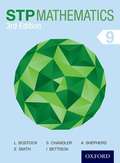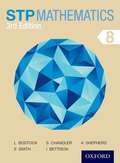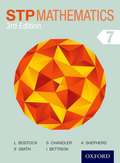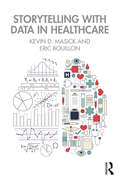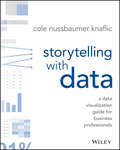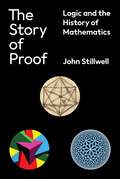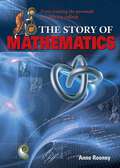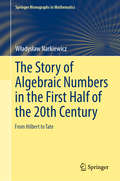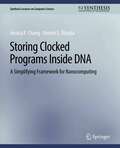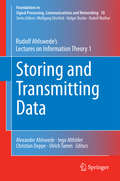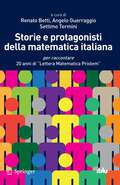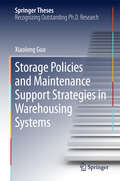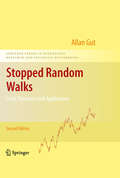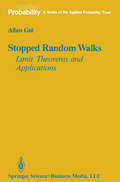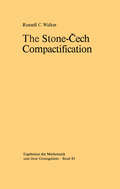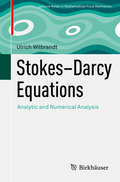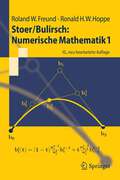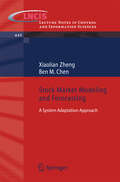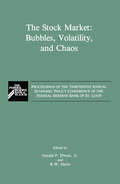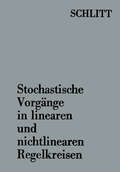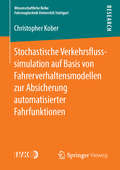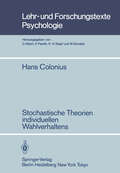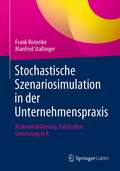- Table View
- List View
STP Mathematics 9 (PDF)
by L Bostock S Chandler E Smith A Shepherd Bettison IThis new edition of the best-selling STP Mathematics series provides all the support you need to deliver the 2014 KS3 Programme of Study. These new student books retain the authoritative and rigorous approach of the previous editions, whilst developing students' problem-solving skills, helping to prepare them for the highest achievement at KS4.
STP Mathematics 8 Student Book
by Sue Chandler Linda Bostock Ewart Smith Ian BettisonThis third edition of the best-selling STP Mathematics series provides all the support you need to deliver the 2014 KS3 curriculum. These student books retain the authoritative and rigorous approach of the previous editions, whilst developing students' problem-solving skills, helping to prepare them for the highest achievement at KS4. Kerboodle resources are also available which include additional assessment activities, online digital versions of the student books and comprehensive teacher support.
STP Mathematics 7 (PDF)
by L Bostock S Chandler E Smith I Bettison A ShepherdThis new edition of the best-selling STP Mathematics series provides all the support you need to deliver the 2014 KS3 Programme of Study. These new student books retain the authoritative and rigorous approach, whilst developing students' problem-solving skills, helping to prepare them for the highest achievement at KS4.
Storytelling with Data in Healthcare
by Kevin Masick Eric BouillonWith the constant evolution of change in healthcare from both a technology and governmental perspective, it is imperative to take a step back and view the big picture. Relying on hunches or beliefs is no longer sustainable, so avoid jumping to conclusions and making decisions without thoroughly understanding the statistics being analyzed. The triple aim of statistics is a conceptual model laying the foundation for improving healthcare outcomes through statistics. This foundation is: know your numbers; develop behavioral interventions; and set goals to drive change.With the availability of electronic data sources, the quantity and quality of data have grown exponentially to the point of information overload. Translating all this data into words that tell a meaningful story is overwhelming. This book takes the reader on a journey that navigates through this data to tell a story that everyone can understand and use to drive improvement. Readers will learn to tell a narrative story based on data, to develop creative, innovative and effective solutions to improve processes and outcomes utilizing the authors’ tools. Topics include mortality and readmission, patient experience, patient safety survey, governmental initiatives, CMS Star Rating and Hospital Compare.Storytelling with Data in Healthcare combines methodology and statistics in the same course material, making it coherent and easier to put into practice. It uses storytelling as a tool for knowledge acquisition and retention and will be valuable for courses in nursing schools, medical schools, pharmacy schools or any healthcare profession that has a research design or statistics course offered to students. The book will be of interest to researchers, academics, healthcare professionals, and students in the fields of healthcare management and operations as well as statistics and data visualization.
Storytelling with Data in Healthcare
by Kevin Masick Eric BouillonWith the constant evolution of change in healthcare from both a technology and governmental perspective, it is imperative to take a step back and view the big picture. Relying on hunches or beliefs is no longer sustainable, so avoid jumping to conclusions and making decisions without thoroughly understanding the statistics being analyzed. The triple aim of statistics is a conceptual model laying the foundation for improving healthcare outcomes through statistics. This foundation is: know your numbers; develop behavioral interventions; and set goals to drive change.With the availability of electronic data sources, the quantity and quality of data have grown exponentially to the point of information overload. Translating all this data into words that tell a meaningful story is overwhelming. This book takes the reader on a journey that navigates through this data to tell a story that everyone can understand and use to drive improvement. Readers will learn to tell a narrative story based on data, to develop creative, innovative and effective solutions to improve processes and outcomes utilizing the authors’ tools. Topics include mortality and readmission, patient experience, patient safety survey, governmental initiatives, CMS Star Rating and Hospital Compare.Storytelling with Data in Healthcare combines methodology and statistics in the same course material, making it coherent and easier to put into practice. It uses storytelling as a tool for knowledge acquisition and retention and will be valuable for courses in nursing schools, medical schools, pharmacy schools or any healthcare profession that has a research design or statistics course offered to students. The book will be of interest to researchers, academics, healthcare professionals, and students in the fields of healthcare management and operations as well as statistics and data visualization.
Storytelling with Data: A Data Visualization Guide for Business Professionals
by Cole Nussbaumer KnaflicDon't simply show your data—tell a story with it! Storytelling with Data teaches you the fundamentals of data visualization and how to communicate effectively with data. You'll discover the power of storytelling and the way to make data a pivotal point in your story. The lessons in this illuminative text are grounded in theory, but made accessible through numerous real-world examples—ready for immediate application to your next graph or presentation. Storytelling is not an inherent skill, especially when it comes to data visualization, and the tools at our disposal don't make it any easier. This book demonstrates how to go beyond conventional tools to reach the root of your data, and how to use your data to create an engaging, informative, compelling story. Specifically, you'll learn how to: Understand the importance of context and audience Determine the appropriate type of graph for your situation Recognize and eliminate the clutter clouding your information Direct your audience's attention to the most important parts of your data Think like a designer and utilize concepts of design in data visualization Leverage the power of storytelling to help your message resonate with your audience Together, the lessons in this book will help you turn your data into high impact visual stories that stick with your audience. Rid your world of ineffective graphs, one exploding 3D pie chart at a time. There is a story in your data—Storytelling with Data will give you the skills and power to tell it!
Storytelling with Data: A Data Visualization Guide for Business Professionals
by Cole Nussbaumer KnaflicDon't simply show your data—tell a story with it! Storytelling with Data teaches you the fundamentals of data visualization and how to communicate effectively with data. You'll discover the power of storytelling and the way to make data a pivotal point in your story. The lessons in this illuminative text are grounded in theory, but made accessible through numerous real-world examples—ready for immediate application to your next graph or presentation. Storytelling is not an inherent skill, especially when it comes to data visualization, and the tools at our disposal don't make it any easier. This book demonstrates how to go beyond conventional tools to reach the root of your data, and how to use your data to create an engaging, informative, compelling story. Specifically, you'll learn how to: Understand the importance of context and audience Determine the appropriate type of graph for your situation Recognize and eliminate the clutter clouding your information Direct your audience's attention to the most important parts of your data Think like a designer and utilize concepts of design in data visualization Leverage the power of storytelling to help your message resonate with your audience Together, the lessons in this book will help you turn your data into high impact visual stories that stick with your audience. Rid your world of ineffective graphs, one exploding 3D pie chart at a time. There is a story in your data—Storytelling with Data will give you the skills and power to tell it!
The Story of Proof: Logic and the History of Mathematics
by John StillwellHow the concept of proof has enabled the creation of mathematical knowledgeThe Story of Proof investigates the evolution of the concept of proof—one of the most significant and defining features of mathematical thought—through critical episodes in its history. From the Pythagorean theorem to modern times, and across all major mathematical disciplines, John Stillwell demonstrates that proof is a mathematically vital concept, inspiring innovation and playing a critical role in generating knowledge.Stillwell begins with Euclid and his influence on the development of geometry and its methods of proof, followed by algebra, which began as a self-contained discipline but later came to rival geometry in its mathematical impact. In particular, the infinite processes of calculus were at first viewed as “infinitesimal algebra,” and calculus became an arena for algebraic, computational proofs rather than axiomatic proofs in the style of Euclid. Stillwell proceeds to the areas of number theory, non-Euclidean geometry, topology, and logic, and peers into the deep chasm between natural number arithmetic and the real numbers. In its depths, Cantor, Gödel, Turing, and others found that the concept of proof is ultimately part of arithmetic. This startling fact imposes fundamental limits on what theorems can be proved and what problems can be solved.Shedding light on the workings of mathematics at its most fundamental levels, The Story of Proof offers a compelling new perspective on the field’s power and progress.
The Story of Mathematics: From creating the pyramids to exploring infinity (The Story of)
by Anne Rooney'In order to understand the universe you must know the language in which it is written. And that language is mathematics.' - Galileo (1564-1642) For hundreds of thousands of years, we have sought order in the apparent chaos of the universe. Mathematics has been our most valuable tool in that search, uncovering the patterns and rules that govern our world and beyond. How the World Works: Mathematics serves as a brilliant introduction to the history and enigmas of this vast discipline, plotting a journey from innumerate cave-dwellers, through the towering mathematical intellects of the last 4,000 years, to the breakthroughs of today. Topics include: • Counting and measuring from the earliest times• The Ancient Egyptians and geometry • Working out the movement of the planets • Algebra, solid geometry and the trigonometric tables • The first computers How statistics came to rule our finances • Impossible shapes and extra dimensions • Measuring and mapping the world • Chaos theory and fuzzy logic • Set theory and the death of numbers The fascinating personalities behind world-changing discoveries in mathematics are profiled, including Euclid, Apollonius, Pythagoras, Brahmagupta, Aryabhata, Liu Hui, Omar Khayyam, al-Khwarizmi, Napier, Galileo, Pascal, Newton, Leibniz, Gauss, Riemann, Russell and many more.
The Story of Algebraic Numbers in the First Half of the 20th Century: From Hilbert to Tate (Springer Monographs in Mathematics)
by Władysław NarkiewiczThe book is aimed at people working in number theory or at least interested in this part of mathematics. It presents the development of the theory of algebraic numbers up to the year 1950 and contains a rather complete bibliography of that period. The reader will get information about results obtained before 1950. It is hoped that this may be helpful in preventing rediscoveries of old results, and might also inspire the reader to look at the work done earlier, which may hide some ideas which could be applied in contemporary research.
Storing Clocked Programs Inside DNA: A Simplifying Framework for Nanocomputing (Synthesis Lectures on Computer Science)
by Chang Jessica Shasha DennisIn the history of modern computation, large mechanical calculators preceded computers. A person would sit there punching keys according to a procedure and a number would eventually appear. Once calculators became fast enough, it became obvious that the critical path was the punching rather than the calculation itself. That is what made the stored program concept vital to further progress. Once the instructions were stored in the machine, the entire computation could run at the speed of the machine. This book shows how to do the same thing for DNA computing. Rather than asking a robot or a person to pour in specific strands at different times in order to cause a DNA computation to occur (by analogy to a person punching numbers and operations into a mechanical calculator), the DNA instructions are stored within the solution and guide the entire computation. We show how to store straight line programs, conditionals, loops, and a rudimentary form of subroutines. To achieve this goal, the book proposes a complete language for describing the intrinsic topology of DNA complexes and nanomachines, along with the dynamics of such a system. We then describe dynamic behavior using a set of basic transitions, which operate on a small neighborhood within a complex in a well-defined way. These transitions can be formalized as purely syntactical functions of the string representations. Building on that foundation, the book proposes a novel machine motif which constitutes an instruction stack, allowing for the clocked release of an arbitrary sequence of DNA instruction or data strands. The clock mechanism is built of special strands of DNA called ""tick"" and ""tock."" Each time a ""tick"" and ""tock"" enter a DNA solution, a strand is released from an instruction stack (by analogy to the way in which as a clock cycle in an electronic computer causes a new instruction to enter a processing unit). As long as there remain strands on the stack, the next cycle will release a new instruction strand. Regardless of the actual strand or component to be released at any particular clock step, the ""tick"" and ""tock"" fuel strands remain the same, thus shifting the burden of work away from the end user of a machine and easing operation. Pre-loaded stacks enable the concept of a stored program to be realized as a physical DNA mechanism. A conceptual example is given of such a stack operating a walker device. The stack allows for a user to operate such a clocked walker by means of simple repetition of adding two fuel types, in contrast to the previous mechanism of adding a unique fuel -- at least 12 different types of strands -- for each step of the mechanism. We demonstrate by a series of experiments conducted in Ned Seeman's lab that it is possible to ""initialize"" a clocked stored program DNA machine. We end the book with a discussion of the design features of a programming language for clocked DNA programming. There is a lot left to do. Table of Contents: Introduction / Notation / A Topological Description of DNA Computing / Machines and Motifs / Experiment: Storing Clocked Programs in DNA / A Clocked DNA Programming Language
Storing and Transmitting Data: Rudolf Ahlswede’s Lectures on Information Theory 1 (Foundations in Signal Processing, Communications and Networking #10)
by Rudolf AhlswedeThe volume “Storing and Transmitting Data” is based on Rudolf Ahlswede's introductory course on "Information Theory I" and presents an introduction to Shannon Theory. Readers, familiar or unfamiliar with the technical intricacies of Information Theory, will benefit considerably from working through the book; especially Chapter VI with its lively comments and uncensored insider views from the world of science and research offers informative and revealing insights. This is the first of several volumes that will serve as a collected research documentation of Rudolf Ahlswede’s lectures on information theory. Each volume includes comments from an invited well-known expert. Holger Boche contributed his insights in the supplement of the present volume.Classical information processing concerns the main tasks of gaining knowledge, storage, transmitting and hiding data. The first task is the prime goal of Statistics. For the two next, Shannon presented an impressive mathematical theory called Information Theory, which he based on probabilistic models. The theory largely involves the concept of codes with small error probabilities in spite of noise in the transmission, which is modeled by channels. The lectures presented in this work are suitable for graduate students in Mathematics, and also in Theoretical Computer Science, Physics, and Electrical Engineering with background in basic Mathematics. The lectures can be used as the basis for courses or to supplement courses in many ways. Ph.D. students will also find research problems, often with conjectures, that offer potential subjects for a thesis. More advanced researchers may find the basis of entire research programs.
Storie e protagonisti della matematica italiana: per raccontare 20 anni di "Lettera Matematica Pristem" (I blu)
by Renato Betti Angelo Guerraggio Settimo Termini20 anni fa – anzi qualcuno in più – iniziava le sue pubblicazioni “Lettera Matematica PRISTEM”, espressione di un gruppo di ricerca della “Bocconi” cui aderiscono anche docenti e studiosi di altre Università. La “Lettera” ha rappresentato un tentativo coraggioso di svecchiare la comunicazione matematica, di renderla meno accademica e più giornalistica con l’uso delle immagini, del colore e di un linguaggio diretto. Un tentativo di inserire la Matematica nei più ampi processi che riguardano la scuola e la società.In questo libro, i tre direttori della rivista sfogliano le sue annate per ricordare storie e personaggi (matematici e non) attorno a cui la “Lettera” è cresciuta e che di fatto hanno contribuito alla formazione della sua linea editoriale.Le testimonianze, i ricordi e i commenti sono seguiti anno per anno da un articolo comparso quell’anno sulla “Lettera”. Ne esce una descrizione del mondo matematico, visto dall’interno, molto più vivace di quanto solitamente si pensa che sia. Altro che semplice calcolo! La Matematica va avanti e la “Lettera” racconta in quali direzioni. Talora procede con appassionate discussioni e qualche polemica che accompagna la ricerca o l’insegnamento o la gestione delle istituzioni scientifiche: anche di queste, in 20 anni, la “Lettera” ha cercato di dare puntualmente conto.
Storage Policies and Maintenance Support Strategies in Warehousing Systems (Springer Theses)
by Xiaolong GuoThis book studies storage policies in warehousing systems and maintenance-support strategies for critical operational systems in warehouses, which are the most important issues affecting operational efficiency of warehousing systems. It expands on the theory of class-based storage by considering a finite number of items in store, and also introduces the maintenance-support strategy founded on performance-based contract theory. It is a valuable resource for researchers, practitioners and engineers in the fields of industrial engineering, operations management, operations research and management science.
Stopped Random Walks: Limit Theorems and Applications (Springer Series in Operations Research and Financial Engineering)
by Allan GutClassical probability theory provides information about random walks after a fixed number of steps. For applications, however, it is more natural to consider random walks evaluated after a random number of steps. Examples are sequential analysis, queuing theory, storage and inventory theory, insurance risk theory, reliability theory, and the theory of contours. Stopped Random Walks: Limit Theorems and Applications shows how this theory can be used to prove limit theorems for renewal counting processes, first passage time processes, and certain two-dimenstional random walks, and to how these results are useful in various applications. This second edition offers updated content and an outlook on further results, extensions and generalizations. A new chapter examines nonlinear renewal processes in order to present the analagous theory for perturbed random walks, modeled as a random walk plus "noise."
Stopped Random Walks: Limit Theorems and Applications (Applied Probability #5)
by Allan GutMy first encounter with renewal theory and its extensions was in 1967/68 when I took a course in probability theory and stochastic processes, where the then recent book Stochastic Processes by Professor N.D. Prabhu was one of the requirements. Later, my teacher, Professor Carl-Gustav Esseen, gave me some problems in this area for a possible thesis, the result of which was Gut (1974a). Over the years I have, on and off, continued research in this field. During this time it has become clear that many limit theorems can be obtained with the aid of limit theorems for random walks indexed by families of positive, integer valued random variables, typically by families of stopping times. During the spring semester of 1984 Professor Prabhu visited Uppsala and very soon got me started on a book focusing on this aspect. I wish to thank him for getting me into this project, for his advice and suggestions, as well as his kindness and hospitality during my stay at Cornell in the spring of 1985. Throughout the writing of this book I have had immense help and support from Svante Janson. He has not only read, but scrutinized, every word and every formula of this and earlier versions of the manuscript. My gratitude to him for all the errors he found, for his perspicacious suggestions and remarks and, above all, for what his unusual personal as well as scientific generosity has meant to me cannot be expressed in words.
The Stone-Čech Compactification (Ergebnisse der Mathematik und ihrer Grenzgebiete. 2. Folge #83)
by R.C. WalkerRecent research has produced a large number of results concerning the Stone-Cech compactification or involving it in a central manner. The goal of this volume is to make many of these results easily accessible by collecting them in a single source together with the necessary introductory material. The author's interest in this area had its origin in his fascination with the classic text Rings of Continuous Functions by Leonard Gillman and Meyer Jerison. This excellent synthesis of algebra and topology appeared in 1960 and did much to draw attention to the Stone-Cech compactification {3X as a tool to investigate the relationships between a space X and the rings C(X) and C*(X) of real-valued continuous functions. Although in the approach taken here {3X is viewed as the object of study rather than as a tool, the influence of Rings of Continuous Functions is clearly evident. Three introductory chapters make the book essentially self-contained and the exposition suitable for the student who has completed a first course in topology at the graduate level. The development of the Stone Cech compactification and the more specialized topological prerequisites are presented in the first chapter. The necessary material on Boolean algebras, including the Stone Representation Theorem, is developed in Chapter 2. A very basic introduction to category theory is presented in the beginning of Chapter 10 and the remainder of the chapter is an introduction to the methods of categorical topology as it relates to the Stone-Cech compactification.
Stokes–Darcy Equations: Analytic and Numerical Analysis (Advances in Mathematical Fluid Mechanics)
by Ulrich WilbrandtThis book offers a thorough guide starting from fundamental functional analysis leading to the coupling of Stokes and Darcy equations, including numerical analysis and scientific computing. Almost all intermediate results are given with complete, rigorous proofs, including theorems which can be rarely found in the literature such that this book serves well as a reference on the topic. Special care is taken to analyze the difficult cases of non-smooth interfaces which are not completely enclosed in one subdomain, i.e, intersect with the outer boundary. This can hardly be found in the literature. Additionally, known and new subdomain iterative methods are introduced, analyzed and applied to standard examples as well as one example motivated by a geoscientific setting.
Stoer/Bulirsch: Numerische Mathematik 1 (Springer-Lehrbuch)
by Roland W. Freund Ronald W. HoppeDieses Numerik-Lehrbuch entwickelte sich seit der 1. Auflage zum Standardwerk. In zahlreichen Lehrveranstaltungen wird es als Begleittext verwendet. Der Erfolg dieses Lehrbuchs ist begründet. Es präsentiert, streng analytisch, grundlegende Prinzipien der Numerischen Mathematik, verknüpft diese aber zugleich mit der praktischen Anwendung, indem es fundamentale algorithmische Werkzeuge bereitstellt und diskutiert. Neue Methodologien und daraus resultierende numerische Verfahren der vergangenen Jahre sind in die 10. Neuauflage integriert: aktualisierte Grundlagen, neue algorithmische Techniken, die kritische Beurteilung existenter Methoden.
Stock Market Modeling and Forecasting: A System Adaptation Approach (Lecture Notes in Control and Information Sciences #442)
by Xiaolian Zheng Ben M. ChenStock Market Modeling and Forecasting translates experience in system adaptation gained in an engineering context to the modeling of financial markets with a view to improving the capture and understanding of market dynamics. The modeling process is considered as identifying a dynamic system in which a real stock market is treated as an unknown plant and the identification model proposed is tuned by feedback of the matching error. Like a physical system, a financial market exhibits fast and slow dynamics corresponding to external (such as company value and profitability) and internal forces (such as investor sentiment and commodity prices) respectively. The framework presented here, consisting of an internal model and an adaptive filter, is successful at considering both fast and slow market dynamics. A double selection method is efficacious in identifying input factors influential in market movements, revealing them to be both frequency- and market-dependent. The authors present work on both developed and developing markets in the shape of the US, Hong Kong, Chinese and Singaporean stock markets. Results from all these sources demonstrate the efficiency of the model framework in identifying significant influences and the quality of its predictive ability; promising results are also obtained by applying the model framework to the forecasting of major market-turning periods. Having shown that system-theoretic ideas can form the core of a novel and effective basis for stock market analysis, the book is completed by an indication of possible and likely future expansions of the research in this area.
The Stock Market: Bubbles, Volatility, and Chaos
by G. P. Dwyer R. W. HaferGerald P. Dwyer, Jr. and R. W. Hafer The articles and commentaries included in this volume were presented at the Federal Reserve Bank of St. Louis' thirteenth annual economic policy conference, held on October 21-22, 1988. The conference focused on the behavior of asset market prices, a topic of increasing interest to both the popular press and to academic journals as the bull market of the 1980s continued. The events that transpired during October, 1987, both in the United States and abroad, provide an informative setting to test alter native theories. In assembling the papers presented during this conference, we asked the authors to explore the issue of asset pricing and financial market behavior from several vantages. Was the crash evidence of the bursting of a speculative bubble? Do we know enough about the work ings of asset markets to hazard an intelligent guess why they dropped so dramatically in such a brief time? Do we know enough to propose regulatory changes that will prevent any such occurrence in the future, or do we want to even if we can? We think that the articles and commentaries contained in this volume provide significant insight to inform and to answer such questions. The article by Behzad Diba surveys existing theoretical and empirical research on rational bubbles in asset prices.
Stochastische Vorgänge in linearen und nichtlinearen Regelkreisen
by Herbert SchlittNachdem die statistischen Verfahren zu einem festen Bestandteil der Rege lungstechnik geworden sind, bedarf die Herausgabe dieses Buches keiner be sonderen Begründung. Es soll zweierlei Aufgaben erfüllen: einerseits sollen die erforderlichen Grundlagen im Bereich der linearen Theorie an den Stoff be reits vorhandener Lehrbücher anschließen, andererseits soll durch die Ein beziehung nichtlinearer Systeme, die von stochastischen Signalen beein fl. ußt werden, eine Lücke in der einschlägigen deutschsprachigen Literatur geschlossen werden. Daß ein erfolgreiches Studium dieses Bandes an die Voraussetzung bestimmter technischer und mathematischer Vorkenntnisse bei dem Leser geknüpft ist, versteht sich von selbst; wesentlicher erscheint mir darüber hinaus die Bereit schaft, die erforderlichen mathematischen Hilfsmittel so eng mit dem physi kalisch-technischen Erfahrungsbereich zu verknüpfen, daß sich eine unauflös bare Einheit ergibt, bei der es kein unbefriedigendes Nebeneinander von tech nisch-physikalischer Realisierung einerseits und rein formaler mathematischer Beschreibung andererseits gibt. In diesem Sinne möchte man sagen, daß die mathematischen Hilfsmittel hier überhaupt nur insoweit interessant sind, als sie einen Beitrag zur Einsicht in die physikalischen Zusammenhänge zu leisten vermögen. Dieser Standpunkt mag mich bei einigen Kritikern dem Vorwurf einer pragmatischen Denkweise aussetzen; ich nehme ihn auf mich, weil er sicherlich aus dem Kreise derer zu erwarten ist, für die dieses Buch nicht geschrieben worden ist. Das Buch ist in zwanzig Abschnitte aufgegliedert, deren zehn erste der Be handlung linearer, zeitinvarianter Systeme gewidmet sind.
Stochastische Verkehrsflusssimulation auf Basis von Fahrerverhaltensmodellen zur Absicherung automatisierter Fahrfunktionen (Wissenschaftliche Reihe Fahrzeugtechnik Universität Stuttgart)
by Christopher KoberChristopher Kober beschreibt eine Methode, realistischen deutschen Autobahnverkehr zu simulieren. Dadurch kann er Fahrerassistenz- und automatisierte Funktionen umfangreicher als bisher in der Simulation und im Labor testen. Der Verkehrsfluss entsteht durch die Interaktion von Fahrerverhaltensmodellen, die er anhand statistischer Untersuchungen parametriert. Den Bezug zu realem Verkehrsfluss stellt der Autor über zwei Fahrsimulatorstudien sowie über die Auswertung von Zählstellendaten her.Der Autor: Christopher Kober arbeitet derzeit im Bereich E/E Testing Prüfstand bei einem deutschen Automobilhersteller. Dort ist er themenverantwortlich für die „Digitale Erprobungsfahrt“, die sich zum Ziel gesetzt hat, eine reale Erprobung durch komplexe Simulation nachzubilden, um E/E-Komponenten im Labor zu testen. Er promovierte berufsbegleitend am Institut für Verbrennungsmotoren und Kraftfahrwesen (IVK) der Universität Stuttgart.
Stochastische Theorien individuellen Wahlverhaltens (Lehr- und Forschungstexte Psychologie #9)
by H. ColoniusStochastische Szenariosimulation in der Unternehmenspraxis: Risikomodellierung, Fallstudien, Umsetzung in R
by Frank Romeike Manfred StallingerDas Buch zeigt, wie Unternehmen durch die Anwendung der stochastischen Szenariosimulation ein wirksames und effizientes Risikomanagement umsetzen können. Die einfache Darstellung der Grundbegriffe und Methoden der Stochastik, ergänzt um Beispiele und Fallstudien aus der Praxis, geben dem Leser ein praxiserprobtes Toolkit an Instrumenten für die praktische Umsetzung mit auf den Weg.Die Autoren führen zunächst in die faszinierende Welt des Zufalls ein und erklären die Grundbegriffe der deskriptiven und auch für das Risikomanagement wichtigen Inferenzstatistik. Anschließend geben sie einen Einblick in erforderliche Wahrscheinlichkeitsverteilungen mit deren Risikomaße und Anwendung in der Praxis und beschreiben Verfahren der Risikoaggregation und der Effizienzbewertung von Risiko-Abmilderungsmaßnahmen. Diese Einführung wird begleitet durch konkrete Fallbeispiele, die in der Programmumgebung „R“ umgesetzt wurden.Ergänzend zur Einführung in die spannende Welt der Stochastik werden in einem separaten Kapitel typische Fallstudien aus der Praxis präsentiert. Die Beispiele werden als Sourcecode in der Programmiersprache „R“ für eine praktische Anwendung sowohl im Buch als auch in elektronischer Form von den Autoren zum Download bereitgestellt.
